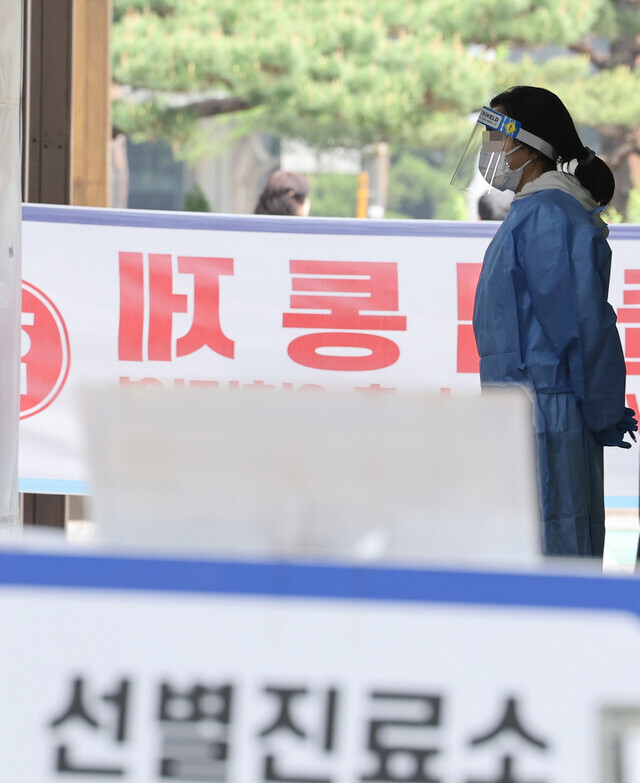hankyoreh
Links to other country sites 다른 나라 사이트 링크
S. Korea mulls dropping outdoor mask mandate amid sharp decline in COVID-19 cases

While restrictions on private gatherings and business hours were completely lifted in South Korea on Monday, the daily COVID-19 caseload in the country continued to drop, falling to the 40,000s for the first time in 68 days. Based on projections that there won’t be another sudden resurgence of the virus anytime soon, the South Korean government is on its way to considering dropping its outdoor mask mandate by next week and making preparations to lift the isolation requirement for those who test positive by May 23.
The Central Disease Control Headquarters announced that South Korea saw 47,743 new cases of COVID-19 as of the end of the day Sunday, almost half the previous day’s figure of 93,001. Sunday’s figure was also 43,174 cases lower than the daily caseload from a week ago, which tallied at 90,917. The last time South Korea saw a daily case count below 50,000 was 68 days ago, when the country recorded 49,546 cases on Feb. 9.
Patients receiving home treatment numbered 742,367 on Sunday, which was 91,691 less than the previous day. Patients in critical condition numbered 850, the figure having fallen to the 800s for the first time in 42 days the day prior. Deaths tallied at 132, having dropped by 71 cases from the previous day’s figure (203).
While noting that “[the daily caseload] had dropped due to fewer tests being administered during the weekend,” Son Young-rae, the Central Disaster Management Headquarters’ head of social strategy, stated during a briefing that “[case counts] were falling steadily [considering the weekday case counts from a week ago].” He projected that while the lifting of social distancing measures may cause caseloads to increase, the effect wouldn’t be significant.
Son explained, “We will be observing potential increases [in COVID numbers] for the next one to two weeks, as [the effect of social distancing measures being dropped] will be visible in case counts and the size of the [next] wave first and foremost.” Still, he said that big changes in daily caseloads aren’t likely, as “the disease control effect of social distancing measures significantly decreased since Omicron compared to the case during Delta.”
The South Korean government is planning to downgrade COVID-19’s infectious disease level from Class 1 to Class 2 by Monday and provisionally lift the isolation requirement for those who test positive around May 23.
Though “the right to take time off while sick” should be guaranteed in order to prevent the adverse effects of making isolation a recommendation rather than a requirement for COVID patients, such as mass infection, the government hasn’t come up with specific plans regarding such concerns. Son commented that authorities are “considering sickness allowances and other supplementary measures so that they can be established institutionally.”
By Park June-yong, staff reporter; Jang Hyeon-eun, staff reporter
Please direct questions or comments to [english@hani.co.kr]

Editorial・opinion
![[Guest essay] Preventing Korean Peninsula from becoming front line of new cold war [Guest essay] Preventing Korean Peninsula from becoming front line of new cold war](https://flexible.img.hani.co.kr/flexible/normal/500/300/imgdb/original/2024/0507/7217150679227807.jpg) [Guest essay] Preventing Korean Peninsula from becoming front line of new cold war
[Guest essay] Preventing Korean Peninsula from becoming front line of new cold war![[Column] The state is back — but is it in business? [Column] The state is back — but is it in business?](https://flexible.img.hani.co.kr/flexible/normal/500/300/imgdb/original/2024/0506/8217149564092725.jpg) [Column] The state is back — but is it in business?
[Column] The state is back — but is it in business?- [Column] Life on our Trisolaris
- [Editorial] Penalties for airing allegations against Korea’s first lady endanger free press
- [Editorial] Yoon must halt procurement of SM-3 interceptor missiles
- [Guest essay] Maybe Korea’s rapid population decline is an opportunity, not a crisis
- [Column] Can Yoon steer diplomacy with Russia, China back on track?
- [Column] Season 2 of special prosecutor probe may be coming to Korea soon
- [Column] Park Geun-hye déjà vu in Yoon Suk-yeol
- [Editorial] New weight of N. Korea’s nuclear threats makes dialogue all the more urgent
Most viewed articles
- 1Yoon’s broken-compass diplomacy is steering Korea into serving US, Japanese interests
- 2[Guest essay] Preventing Korean Peninsula from becoming front line of new cold war
- 3[Column] Why Korea’s hard right is fated to lose
- 460% of young Koreans see no need to have kids after marriage
- 5After 2 years in office, Yoon’s promises of fairness, common sense ring hollow
- 6S. Korean first lady likely to face questioning by prosecutors over Dior handbag scandal
- 7[Guest essay] Maybe Korea’s rapid population decline is an opportunity, not a crisis
- 8[Reporter’s notebook] In Min’s world, she’s the artist — and NewJeans is her art
- 9Film on 1948 Jeju Massacre wins prestigious prize at Sundance Film Festival
- 10[News analysis] Jo Song-gil’s defection and its potential impact on inter-Korean relations